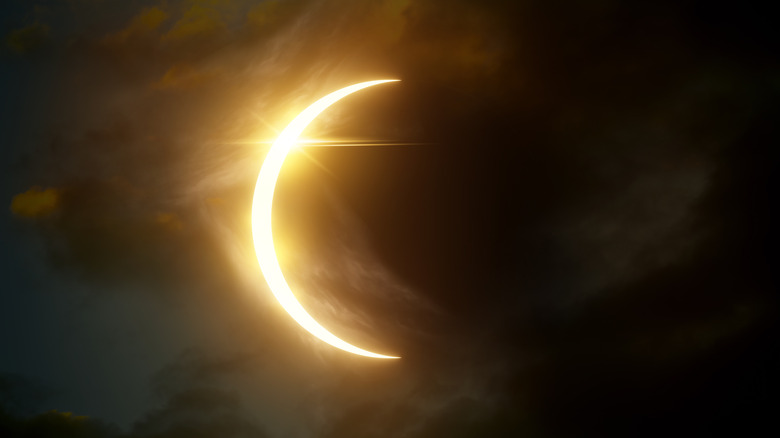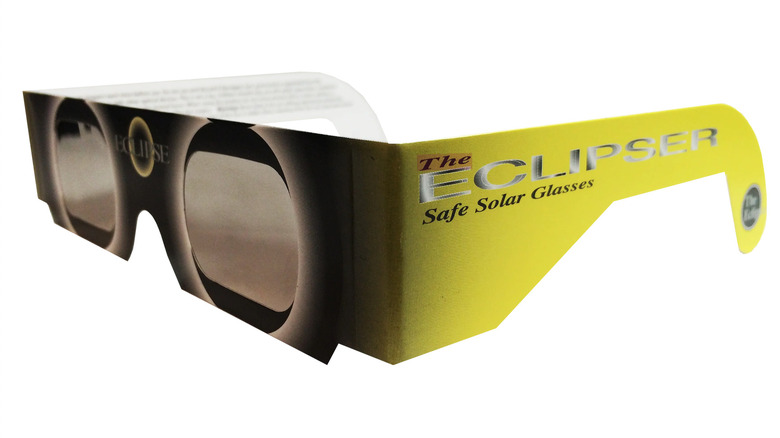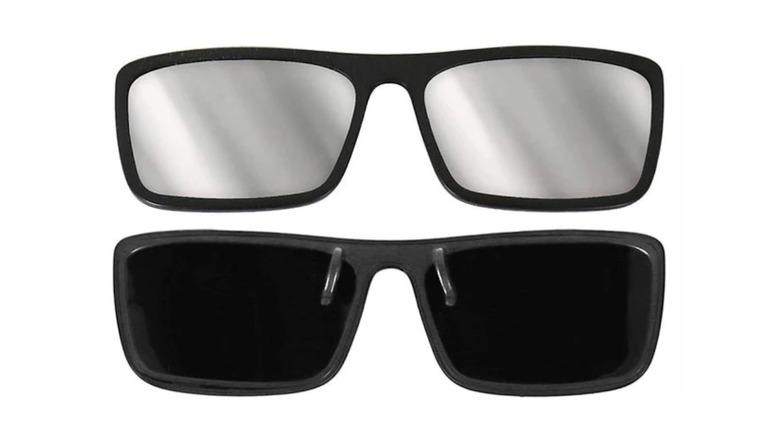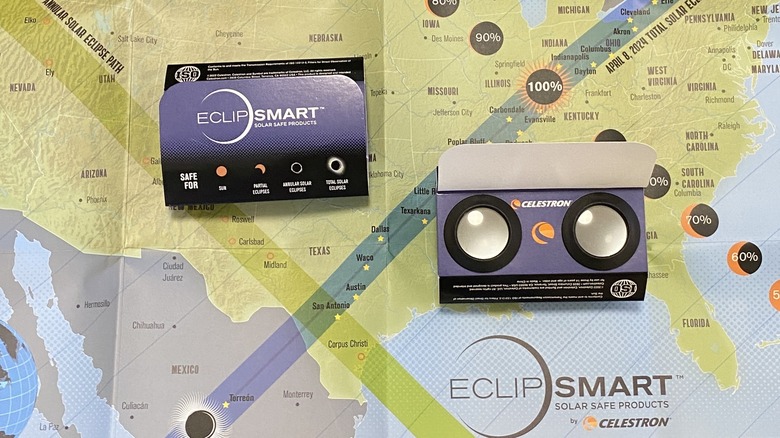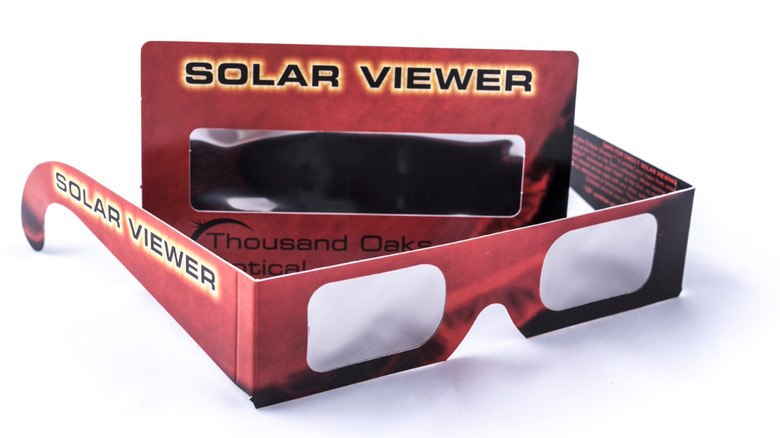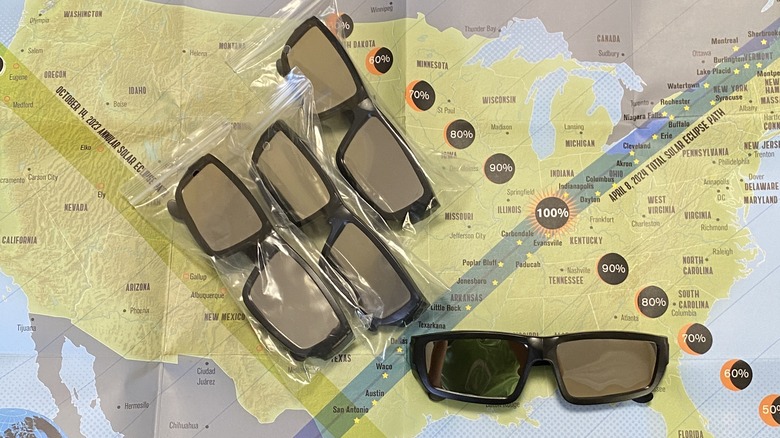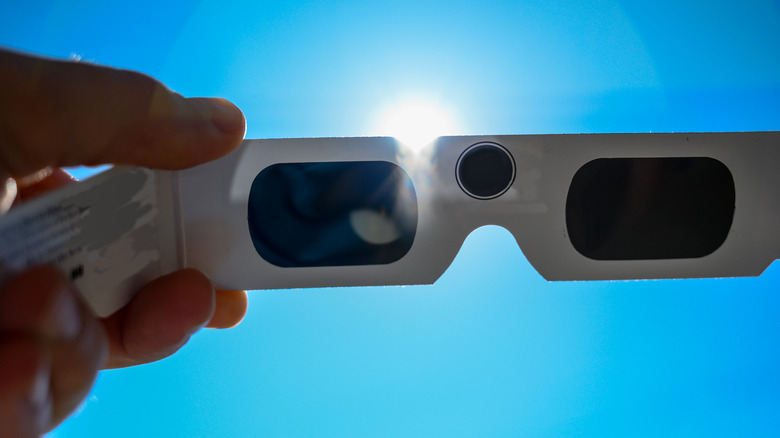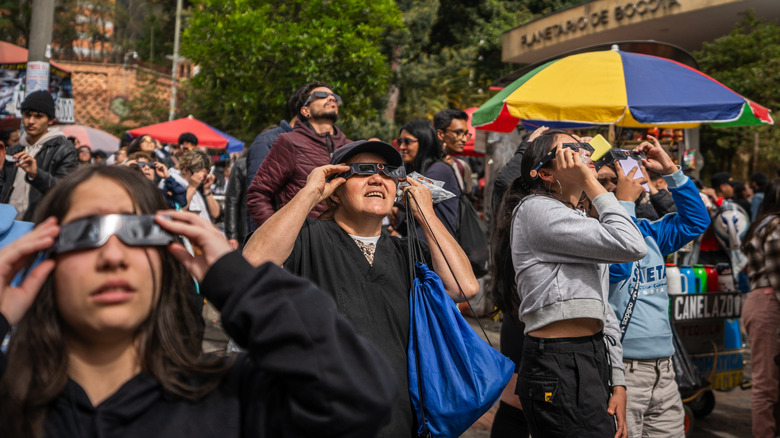5 Of The Best Glasses For Viewing This Year's Solar Eclipse
A total solar eclipse will take place across eastern North America on April 8, 2024, and you'll want to make sure you don't miss the rare cosmic event — another one won't occur in the U.S. for two decades. All of the contiguous U.S. will see at least a partial eclipse, where some (if not most) of the sun will be covered by the moon. When the sun is totally obscured, the sky will become as dark as dusk, and its outer atmosphere will be briefly visible to the naked eye. However, even when just 1% of the sun is still visible, it's too bright to look at without proper eye protection, and doing so could seriously damage to your vision. That's why it's very important to equip yourself with proper solar eclipse glasses that can filter out nearly all visible light — which a regular pair of sunglasses can't do.
To protect your eyes, you need to make sure you purchase a quality pair of solar eclipse glasses, which are relatively affordable. NASA doesn't officially approve of any solar viewer brands, but it does urge you to only use ones with an ISO 12312-2 international standard or above, which permits a maximum of 0.0032 percent light through their lenses. That's still more than enough light to see the sun's surface. (You can also use welder's glasses rated 14 or higher.) The American Astronomical Society (AAS) also tests many different solar eclipse glasses to see if they're properly filtered.
To help you decide which solar viewers are safe to use and worth your investment, here are five of the best glasses for taking in this year's total eclipse. You'll want to act quickly though — many solar viewers are selling out fast as the 2024 eclipse approaches.
The Eclipser by American Paper Optics
American Paper Optics has made glasses for three decades and is one of the brands tested and approved by the AAS. The Eclipser glasses are coated in a 2-millimeter scratch-resistant black polymer and are ISO 12312-2 certified. They show the sun in its natural orange color while blocking 99.999 percent of visible light, as well as 100 percent infrared light and harmful UV rays.
The glasses are also affordable — you can purchase a pack of five for less than what a pair or two might cost from other popular brands. They also come in a wide assortment of different designs, so you can have some fun and choose a snazzy set, which your friends, children, or students may really appreciate. Some designs are already out of stock and more may sell out as the U.S. solar eclipse approaches, so you'll want to purchase yours soon if there's a particular style you like.
One drawback is that most of the designs are made of thin cardboard, making them flimsy and easily damaged if mishandled. Plastic models of the Eclipser are available, though they're more expensive and may sell out of stock faster. A pack of five yellow paper pairs of The Eclipser by American Paper Optics is available from Amazon for $16.99.
Rainbow Symphony Clip-On Solar Eclipse Glasses
Approved by the AAS, Rainbow Symphony was founded over 40 years ago and is the largest manufacturer of eclipse glasses in the world. The company also makes solar viewers and solar filters for telescopes and binoculars, and its Clip-On Solar Eclipse Glasses are an innovative solution for those who wear prescription eyeglasses. They easily attach to your frames and filter out nearly all light since they're ISO 12312-2 certified.
Of course, if you don't wear glasses, you might be better off going with an actual pair of solar eclipse glasses, since you won't have anything to clip this product onto. (Or, you can hold them up to your face if you don't mind putting your arms to use during the eclipse.) Rainbow Symphony does manufacture a quality set of stylish, plastic solar eclipse glasses, though they're a little more pricey.
Rainbow Symphony Clip-On Solar Eclipse Glasses are one of the highest-rated solar viewers on Amazon, with a 4.6 out of 5 score based on over 1,000 customer ratings. You can purchase a pair for $19.95 on Amazon, which comes with two pairs of paper solar eclipse glasses that you can share or use yourself.
Celestron EclipSmart Safe Solar Power Viewers
Celestron is one of the biggest names in consumer astronomy gear and makes one of the best telescopes for beginners on the market. Its Eclipsmart brand of solar viewers is also very popular, as well as approved by the AAS. The Celestron EclipSmart Safe Solar Power Viewers are unlike many other solar eclipse glasses, because these ISO 12312-2 certified lenses have a 2x magnification and are essentially solar eclipse binoculars — allowing you to get an even closer look at the sun and solar eclipse. This also makes them great for seeing smaller phenomena, such as when Mercury or Venus transit across the sun.
I personally tested this pair and they work great. The magnification aspect is cool, but may not be the experience you're looking for when viewing this year's solar eclipse. Like with using cheap binoculars, the magnified image isn't quite as sharp as it would be if you were looking at the sun in its natural size. You also need to hold them up to your face since they don't naturally rest on your ears, and while their cardboard construction isn't exactly flimsy, it's not as durable as plastic (I also bought a regular pair of plastic glasses so I could view the eclipse with both methods). But if you want to see the eclipse up close and personal with magnified lenses, you can purchase a two-pack of Celestron EclipSmart Safe Solar Power Viewers for $12.95, which comes with a handy 2024 solar eclipse map of North America.
Thousand Oaks Solar Eclipse Glasses
The Thousand Oaks Solar Eclipse Glasses are another quality option approved by the AAS. They are ISO 12312-2 certified and boast a 4.5 out of 5 average user rating on Amazon. Using proprietary high-quality substrates, the silver-black polymer lenses used by Thousand Oaks are resistant to pinholes or scratches that could ruin the glasses and show a sharp solar image in orange when viewing the sun.
Like other cardboard solar viewers, they're fairly flimsy, so you'll need to be careful that you don't damage them. However, Thousand Oaks Solar Eclipse Glasses are also one of the most affordable quality solar eclipse glasses on the market. You can purchase a five-pack from Amazon for just $14.00, and you can also get them in bulk amounts of 10 or 50 if you're buying for your family, classroom, or astronomy club (or, if you're a huge space geek like me, your whole office).
Thousand Oaks also manufactures popular solar filters for cameras, binoculars, and telescopes.
Tesyker Family Set
I own and personally tested the Tesyker Family Set of solar eclipse glasses, which is a good option if you're buying for your loved ones and prefer hard plastic glasses over more fragile cardboard ones. The set comes with two pairs each of adult-sized and child-sized plastic glasses, as well as two paper pairs.
Their polymer lenses are ISO 12312-2 certified and filter 100 percent of UV and infrared light. Tesyker is one of the brands tested and approved by the American Astronomical Society, but I can also confirm the efficacy of their plastic-framed viewers based on my own hands-on testing, which included staring up at the hot Los Angeles sun from a wide-open parking lot. The glasses filtered out all light except for the sun itself, and its orange surface was clear and easy to see.
However, the included paper glasses did not work sufficiently — the sun was noticeably brighter, and after just a few seconds it was too hard to look at. My vision was blurred from the sun damage for nearly an hour afterward, making it clear the lenses are not strong enough for viewing the solar eclipse and are basically worthless. As long as you toss out the paper glasses that come with the set, you can still use the included plastic frames, which felt comfortable to wear and fully covered both of my eyes. I don't regret the purchase, considering I prefer the plastic frames anyway, but this could be a dealbreaker for you and your family. You can find the Tesyker Family Set on Amazon for $29.99.
Carefully inspect any solar eclipse glasses you purchase
Even with solar eclipse glasses manufactured by brands vetted by the AAS and/or made with the ISO 12312-2 international standard, it's still very important that you thoroughly inspect any pair before using it to look directly at the sun. Examine the lenses carefully and make sure there are no scratches, tears, pinholes, or other damage. If even a tiny fraction of unfiltered sunlight is allowed through, the glasses are completely unusable.
After you check your glasses and confirm no visible damage, you should briefly test them by looking up at the sun while wearing them. If the sun is still bright enough to make you squint or hurt your eyes, they're likely not up to the ISO 12312-2 international standard and not strong enough to safely use. You'll know the solar viewers are working properly if you can easily look at the sun for a few minutes without straining your eyes. Most proper viewers contain warnings to avoid looking directly at the sun for more than a few consecutive minutes at any given time, though AAS says this doesn't apply to ISO-certified products.
After you confirm your solar eclipse glasses are working properly, you still can't use them to look through normal binoculars or telescopes — sunlight may be magnified in these optical devices and overwhelm the filters in your lenses. If you do want to use optical devices to view the solar eclipse, you can buy proper solar filters that attach to their lenses. Filters like these protect both your eyes and the optical devices themselves and can even allow you to photograph a solar eclipse.
How these solar eclipse glasses were selected
It's very important that if you use a solar viewer to look at the sun, it's properly filtered and works as advertised — you can't risk damaging your vision with inferior products. While NASA doesn't officially endorse any specific brands, it does strongly recommend you use solar viewers made to the ISO 12312-2 international standard or above. All the solar eclipse glasses on this list claim to use this standard — anything lower is not worth your money and shouldn't be used at all. Additionally, many members of the AAS have personally tested and vetted several brands of solar eclipse glasses, and the group has even published a list of approved brands. All the products on SlashGear's list have been approved by the AAS. Two of the brands have also been personally tested by myself to ensure that — even when looking at the bright LA sun — they properly filter out enough light to safely use.
Amazon user ratings have also been taken into consideration, since customers who've bought the products can also verify if they work as advertised. The five viewers on this list have an Amazon customer score of 4 out of 5 or higher. The Celestron EclipSmart Safe Solar Power Viewers achieve a verification trifecta — they have a high Amazon score, have been personally tested by me, and are approved by the AAS. However, since solar viewers are a niche product, most brands don't have more than a few hundred user ratings, if not less, which makes these scores not necessarily a reliable metric on their own. The Tesyker glasses also achieve a verification trifecta, though their high Amazon rating is based on only a few dozen ratings. Nevertheless, they help support other evidence that the products on this list are safe to use and are some of the best glasses available for viewing this year's solar eclipse.
